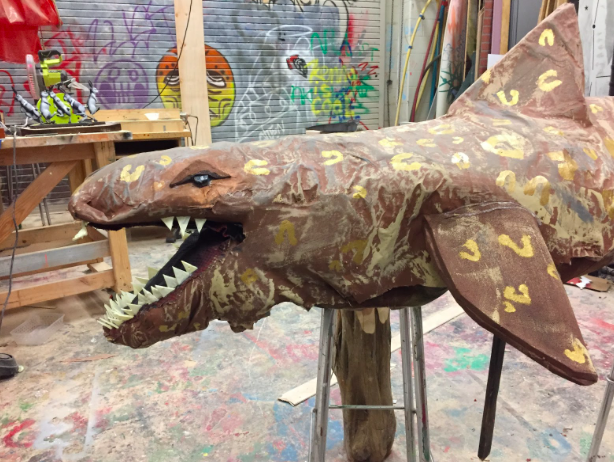“The Little Mermaid” wows with unconventional puppets
More stories from Becca Pirkle
When Grady Drama teacher Jake Dreiling first announced that Grady would perform its spring musical, the Little Mermaid, as a puppet show, many students were skeptical. They had never designed or created puppets before and were wary of how the venture into uncharted territory would turn out. However, Dreiling had a vision, one that included giant, life-like puppets and dozens of sea creatures that would eventually transform the stage into a teeming ocean.
In the months leading up to the show, Grady students built over 40 original puppets. Each actor had a hand in creating their own puppet. Junior Eden Artelli served as the puppet master, supervising everyone’s progress, helping people with their puppets, and making sure each puppet fit in with the show.
“I think that being puppet master is quite possibly the hardest thing I’ve ever done in Grady drama,” Artelli said. “ I had never designed puppets before, let alone created them. I had to teach myself how to make them through trial and error while also teaching others. To say it was hard is an understatement.”
For Artelli, the most difficult part was making the puppets look realistic. The puppets had to mimic real sea animals and move across the stage as if they were actually swimming. The larger puppets, such as the sharks and the whale, weighed more and had to be supported by up to three students each.
The student began building the sharks with a tube skeleton. They covered the skeleton in foam and primer, and then painted the body to look like a real shark, adding rows of sharp teeth and realistic details. Junior Zoe Spangler was one of three people who helped carry the sand shark on stage. Each person supported the shark by carrying a horizontal rod inside the shark’s belly.
“It was such a great experience,” Spangler said. “It was so cool that we got to show off our puppets that we having been making since August”
Aside from sea creatures, the show also featured an ensemble of crickets, turtles, grasshoppers and seagulls that harmonized during Kiss the Girl. The gulls were made from wire frames, their heads and beaks constructed out of cardboard, and fabric hot glued on to create feathers.
During the song, a blue strip of fabric was stretched across the stage to mimic water, and Ariel (junior Amelia Kushner) and Eric (senior Alex Tischer) drifted in a wooden boat behind the waterline. Colorful lights reflected off of light strips of fabric that hung from the ceiling, transforming the fabric into swaying Spanish moss.
Junior Jill Calderon, stage manager, came up with the idea to hang the strips of fabric from the ceiling. During the Ursula scenes (played by senior Olivia Hunter), the lights illuminating the fabric changed to dark purples and reds, creating an ominous, evil feeling of the sea witch’s lair. In the open ocean scenes, white and green lights shone on the fabric to mimic a clear, rippling ocean.
Over the course of almost six months, Grady students worked to produce Grady’s first ever puppet show. They studied images of marine life to capture the correct details on their numerous puppets, and also built ships and rocks and coral as additional set pieces.
“I am so incredibly grateful for this opportunity. At the time it was very stressful, but in the end, I learned such valuable lessons and skills from this experience. I’m so proud of the end product that this show will be ingrained in my mind for the rest of my life,” Artelli said.

